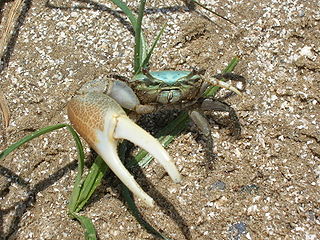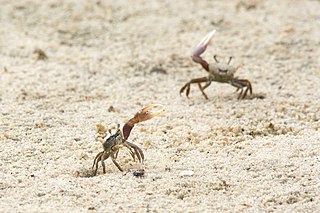
The fiddler crab or calling crab can be one of the hundred species of semiterrestrial marine crabs in the family Ocypodidae. These crabs are well known for their extreme sexual dimorphism, where the male crabs have a major claw significantly larger than their minor claw, whilst females claws are both the same size. The name fiddler crab comes from the appearance of their small and large claw together, looking similar to a fiddle.

The Ocypodidae are a family of semiterrestrial crabs that includes the ghost crabs and fiddler crabs. They are found on tropical and temperate shorelines around the world.

Minuca pugnax, commonly known as the Atlantic marsh fiddler crab, is a species of fiddler crab that lives on north-western shores of the Atlantic Ocean.

Austruca mjoebergi is a species of fiddler crab discovered by and named after the Swedish zoologist Eric Mjöberg (1882–1938), member of a Swedish scientific expedition to Australia in the early 1900s.

Austruca perplexa is a species of fiddler crab. It is found from the Ryukyu Islands, Japan to India, throughout the Malay Archipelago, along eastern Australian coasts from Queensland to New South Wales, and in various Pacific islands, including Fiji, Tonga and Vanuatu.

Gelasimus vocans is a species of fiddler crab. It is found across the Indo-Pacific from the Red Sea, Zanzibar and Madagascar to Indonesia and the central Pacific Ocean. It lives in burrows up to 50 centimetres (20 in) deep. Several forms of G. vocans have been recognised, with their authors often granting them the taxonomic rank of full species or subspecies.

Paraleptuca chlorophthalmus, is a common fiddler crab found in the mangroves of East Africa, from Somalia to South Africa, as well as Madagascar and Mauritius. Marsh fiddlers dig burrows in the muddy or sandy banks of salt marshes, which they use to protect themselves from predators, high tide and extreme temperatures. They feed by filtering detritus out of mud, and defend their burrows against other fiddler crabs. Paraleptuca chlorophthalmus is characterised by its red pereiopods and blue and black markings on its carapace.

Minuca minax, commonly known as the red‐jointed fiddler crab or brackish-water fiddler crab, is a species of fiddler crab that is found in the United States from Massachusetts to the Gulf of Mexico. It is one of the most common macroinvertebrates in salt marshes in these states. It prefers areas of lower salinity than other fiddler crabs, and can be found in great numbers along the banks of tidal streams, even at distances greater than 50 km (31 mi) from the sea.

Minuca longisignalis, the longwave gulf fiddler, is a species of American broad-front fiddler crab in the family Ocypodidae.

Leptuca thayeri, known generally as the Atlantic mangrove fiddler crab or mangrove fiddler, is a species of true crab in the family Ocypodidae. It is distributed all across the Western Atlantic.

Austruca is a genus of Indo-west Pacific fiddler crabs in the family Ocypodidae. There are about 13 described species in this genus.

Leptuca panacea, commonly known as the Gulf sand fiddler crab or the Panacea sand fiddler, is a species of fiddler crab native to coastal habitats along the Gulf of Mexico from northwestern Florida to Mexico.
Leptuca cumulanta, commonly known as the heaping fiddler crab or the mangrove fiddler crab, is a species of fiddler crab native to tropical and subtropical areas of the western Atlantic.
Leptuca beebei, commonly known as Beebe's fiddler crab, is a species of fiddler crab native to the Pacific coasts of Central and South America, from El Salvador to northern Peru.
Leptuca batuenta, commonly known as the beating fiddler crab, is a species of fiddler crab native to the tropical eastern Pacific, from El Salvador to northern Peru.
Leptuca saltitanta, commonly known as the energetic fiddler crab, is a species of fiddler crab native to the eastern Pacific coasts, from El Salvador in Central America to Colombia in South America.
Leptuca deichmanni, commonly known as Deichmann's fiddler crab, is a species of fiddler crab native to the eastern Pacific coast of Central America, in Costa Rica and Panama.
Leptuca terpsichores, commonly known as the dancing fiddler crab, is a species of fiddler crab native to the eastern Pacific coast of the Americas, from Nicaragua to Peru.

Tubuca polita, commonly known as the polished fiddler crab. or pink-clawed fiddler crab is a species of fiddler crab that is found in the northern part of Australia including the Torres Strait Islands

Tubuca dussumieri, is a species of fiddler crab that is found in the western and south pacific including New Caledonia, Indonesia, Malaysia, Taiwan, Japan, north eastern Australia
















